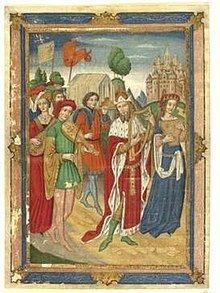 | ||
The Spanish Forger is the name given to an unidentified individual who, in the late 19th to early 20th century, created a large number of forgeries of medieval miniatures.
The Spanish Forger's works were painted on vellum or parchment leaves of genuine medieval books, using either blank margins or scraping off the original writing. He also “completed” unfinished miniatures or added missing miniatures in medieval choir books. His works fooled many experts and collectors and appear today in the collections of many museums and libraries. Over 200 forgeries have been identified.
As recently as 1930, the Forger was believed to be of Spanish origin. This is due to the fact that one of his first identified forgeries was attributed as a genuine work by Maestro Jorge Inglès, a Spanish artist who was active during the fifteenth century. However, when one considers the provenance of the Forger’s pieces along with many of the medieval collectible miniatures of the period, Paris was the center of purchasing, selling, and forging. A number of his forged miniatures have been identified as copied, with modifications, from those published in several French books dating to the 1870s −1880s.
His works were very deceptive when created, but over time it has been recognized that the faces of individuals in his pictures have “sugary expressions” inconsistent with genuine medieval illuminations. Some of his miniatures have also been identified as forgeries because they are of secular scenes that would not have appeared in genuine medieval religious texts. Additionally, many of the individuals in the Spanish Forger’s miniatures have a tilt to their heads that would not be present in authentic medieval works. In the “Knights of the Crusade” miniature, the bearded knight at the gate and the maiden in the bottom embellishment exhibit the classic head tilt. Also, the facial expressions on most of the subjects in his miniatures are sweet and cloying, not pious and pensive as with true works. In legitimate medieval works, gold leaf was added first so that the paints would not be obscured by it. However, the Spanish Forger used gold leaf as a final touch, obscuring his paints and giving a lustrous appearance to his forgeries.
Up to a certain point, most of the Spanish Forger’s miniatures had been identified due to unique stylistic characteristics. In 2009, Lucia Burgio, Robin Clark, and Richard Hark performed spectroscopic investigation, comprehensive analysis of pigments by Raman microscopy and X-ray fluorescence, upon five of the Spanish Forger’s miniatures in order to determine with scientific certainty that the forgeries were exactly that. Use of the pigments ultramarine blue (synthesized after 1828) and Scheele’s green (synthesized after 1775) were discovered due to their findings, providing solid evidence that the Forger’s imitations were fabricated in a post-medieval period.
The Spanish Forger’s works were the subject of an exhibition at the Morgan Library in New York City in 1978, for which an extensive catalog was published. His works are now themselves collected as forgeries, selling for several thousand dollars each. He circulated over 194 imitations, which have been identified, around the end of the nineteenth century and the beginning of the twentieth century to multiple collectors of medieval art.
In January 2009, it was announced that the Victoria and Albert Museum purposely acquired five examples of the Spanish Forger's work for their collection "for what it tells us about late 19th-century perceptions." The museum took the works in lieu of ₤20,000 ($US 30,000) of inheritance tax, equivalent to a value per work of about $6,000. Another of the artist's paintings appeared on Antiques Roadshow in 2014, being valued at around $4,000.
